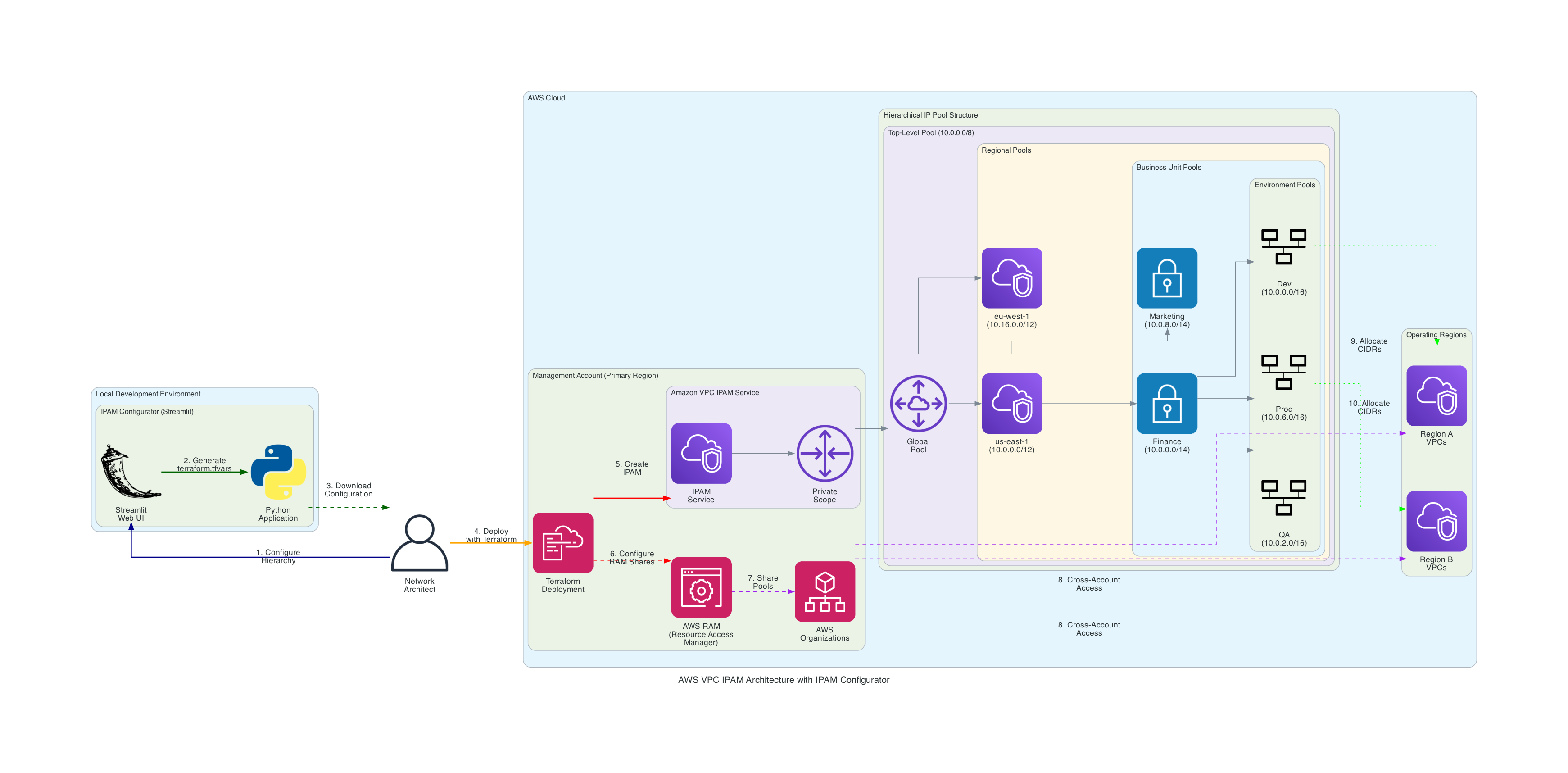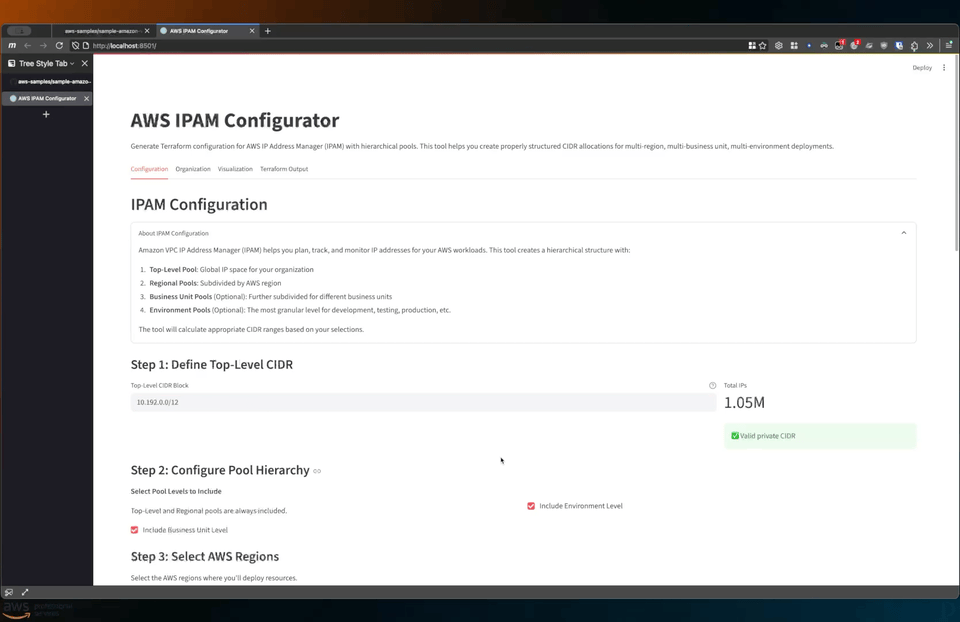Managing IP address space across large AWS environments is more complex than most organizations anticipate. When you're dealing with multiple AWS accounts, regions, and business units, traditional spreadsheet-based IP management quickly becomes a bottleneck that leads to conflicts, delays, and security gaps.
During my time at AWS, I've seen countless enterprises struggle with IP address allocation, especially when scaling across multiple regions or during cloud migrations. The manual processes, lack of automation, and absence of centralized governance create operational overhead that slows down development teams and increases risk.
That's why I built this comprehensive Amazon VPC IP Address Manager (IPAM) solution—to demonstrate how enterprise-grade network management can be automated, governed, and scaled using Infrastructure as Code.
The solution implements a sophisticated four-tier hierarchical pool structure that mirrors real-world organizational requirements. The diagram below illustrates the complete architecture and data flow from the IPAM Configurator through to deployment:

Top-Level Pool (Global CIDR: 10.0.0.0/8)
├── Regional Pools (per AWS region: 10.0.0.0/12)
│ ├── Business Unit Pools (per BU: 10.0.0.0/14)
│ │ └── Environment Pools (dev/qa/prod: 10.0.0.0/16)This hierarchy provides several key benefits:
- ▶Organizational Alignment: Matches business unit and environment structure
- ▶Scalable Governance: Policies applied at appropriate hierarchy levels
- ▶Conflict Prevention: Automatic CIDR containment validation
- ▶Multi-Region Consistency: Centralized control with regional allocation
The standout feature of this solution is the "IPAM Configurator"—a Streamlit-based web application that revolutionizes how organizations plan and deploy their IPAM infrastructure.

Traditional IPAM planning involves complex subnet math, spreadsheets, and manual validation that's error-prone and time-consuming. The IPAM Configurator eliminates these pain points with an interactive, visual approach to network design.
Key Configurator Features:
- • Interactive Web Interface with real-time validation
- • Automated CIDR calculation with containment checking
- • Visual representation via Sunburst diagrams
- • Terraform tfvars file generation
- • Drag-and-drop resource ordering
- • Flexible reservation strategies
- • Multi-tab workflow design
The tool is built using modern Python technologies including Streamlit for the web interface, Pandas for data manipulation, Plotly for visualization, and NetworkX for graph operations. The core logic handles complex CIDR validation and hierarchical allocation calculations that would typically require manual verification.
Watch this complete demonstration showing the entire process from cloning the AWS Samples repository to deploying the IPAM solution with Terraform:
The Terraform implementation follows enterprise-grade patterns with comprehensive validation, modular design, and operational excellence principles:
AWS Resources
- • Amazon VPC IPAM instance
- • IPAM scopes for private IP management
- • Hierarchical IPAM pools (~67 pools)
- • AWS RAM resource shares
- • Cross-account principal associations
Terraform Modules
- • Root orchestration module
- • Core IPAM hierarchy module
- • Standardized tags module
- • Validation logic module
- • Cross-region compatibility
One of the most challenging aspects was implementing comprehensive validation logic to prevent configuration errors. The solution includes CIDR containment validation, relationship checking across hierarchy levels, and automated conflict detection.
# Example validation pattern
validation {
condition = can(cidrsubnet(var.top_level_cidr,
var.regional_prefix_length - split("/", var.top_level_cidr)[1], 0))
error_message = "Regional pools must fit within top-level CIDR allocation."
}🚀 Try It Yourself:
The complete solution is available as an AWS Sample on GitHub. Clone the repository and follow the demo above to deploy your own enterprise IPAM solution:
git clone https://github.com/aws-samples/sample-amazon-vpc-ipam-terraformThis IPAM solution is designed to integrate seamlessly with enterprise AWS environments and existing Infrastructure as Code workflows:
AWS Organizations Integration
The solution leverages AWS Resource Access Manager (RAM) to share IPAM pools across organizational accounts. This enables centralized governance while allowing distributed teams to provision VPCs using organization-managed IP space.
Account Factory for Terraform (AFT) Compatibility
For organizations using AFT, this IPAM solution can be deployed as a global customization, providing immediate IP management capabilities for newly provisioned accounts.
Downstream VPC Provisioning
VPC modules can directly reference IPAM pools using data sources, eliminating manual CIDR specification and ensuring automatic compliance with organizational IP allocation policies.
# VPC integration example
resource "aws_vpc" "main" {
ipv4_ipam_pool_id = data.aws_vpc_ipam_pool.environment.id
ipv4_netmask_length = 18
tags = {
Name = "production-vpc"
Environment = "prod"
}
}Beyond the technical implementation, this solution addresses critical operational requirements for enterprise environments:
Compliance & Governance
- ▶ Auto-import capabilities for existing VPCs and subnets into appropriate pools
- ▶ Policy-based allocation rules preventing overlapping address space
- ▶ Reserved CIDR functionality for infrastructure and future expansion
Monitoring & Observability
- ▶ CloudWatch integration for IPAM utilization metrics
- ▶ Audit trails for all IP allocation and deallocation events
- ▶ Compliance reporting for organizational IP usage patterns
Cost Optimization
The solution includes cost-aware design patterns, utilizing AWS free tier where possible and implementing efficient resource tagging for cost allocation across business units and environments.
Building this IPAM solution taught me several important lessons about enterprise infrastructure automation:
The Power of Visual Planning Tools
The IPAM Configurator's visual interface dramatically reduces the time from network design to deployment. What used to take days of spreadsheet work and manual validation can now be accomplished in hours with immediate visual feedback and automated validation.
Validation is Critical
Complex infrastructure solutions require comprehensive validation at multiple levels. The time invested in building robust validation logic pays dividends by preventing costly misconfigurations and deployment failures.
Enterprise Integration Patterns Matter
Solutions that don't integrate well with existing enterprise patterns and workflows will struggle for adoption. This IPAM solution was designed from the ground up to work with AWS Organizations, AFT, and common enterprise Terraform patterns.
This AWS VPC IPAM solution represents the kind of enterprise-grade infrastructure automation that can dramatically improve operational efficiency while reducing risk. The combination of Terraform best practices, comprehensive validation, and innovative tooling creates a solution that scales with organizational growth.
Whether you're planning a cloud migration, scaling across multiple AWS regions, or looking to implement better governance around IP address management, this solution provides a proven pattern that can be adapted to your specific requirements.
Interested in implementing similar infrastructure automation for your organization? Let's discuss how enterprise-grade Infrastructure as Code can solve your specific networking challenges.
Get in TouchDonny Schreiber
AWS Security Consultant with 10+ years of enterprise cybersecurity experience. Specialized in Infrastructure as Code, AWS security architecture, and automation solutions. Based in Boulder, Colorado.
About Me: From Enterprise Security to AI-Powered Consulting
My journey from enterprise cybersecurity to AWS consulting and founding SchreiberCyber.
Building an AI Security Strategy
How to safely implement AI tools while maintaining security posture.